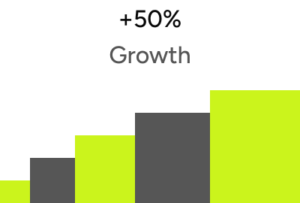Generating leads for an agency on demand is hard—especially for the type of clients we love working with.
Since we’re selling an £18k to £45k contract (that’s between £3.5k to £7.5k per month for a minimum of 6 months), it’s challenging to find qualified leads. The best ones came from brands that know what they want and are actively searching for SEO assistance. Likewise, we also had strong leads come through referrals from our network.
Here’s the thing. Most of these leads already had two things going for them. They either knew who we were already or understood the value of SEO and were seeking support from an agency like us.
We had to think about this realistically. What was holding us back from signing client after client? Considering the impressive results we’ve achieved with our clientele, we trusted our service was providing what we knew it could. So, since our close rate is 30% on proposals, we hypothesised our issue was to do with getting people to knock on our door.
What Limitations Were We Facing?
We knew that outbound prospecting for SEO is very hard. There are many things that must be right timing-wise for a business to consider SEO as a growth channel. So, it’s imperative we position ourselves as the obvious choice when they are ready.
As you can see, this highlights a clear limitation for our growth potential. Our ability to scale is tied to our brand awareness.
Fortunately, we have lots of drip-feeding strategies to combat this, such as attending events and running workshops. However, this is a long-term approach. We wanted a quick catalyst to get a bunch of new leads through the door.
We needed to get crystal clear on what was stopping businesses from coming to us for growth support rather than us reaching out to them. We’ve already emphasised some of the pain points above, including the need for strong brand awareness. More than this, though, through our efforts to onboard brands, we realised many of them had one thing in common. The decision-makers (CEOs, CMOs, and marketing leads) didn’t fully understand or grasp the true value of doing SEO work.
Education and SEO awareness are monumental in attracting new clients, thus, indicating another pain point in our strategy. So, what else did we identify?
- SEO is expensive and perceived as a “spammy” word, which fundamentally means people don’t truly understand it.
- Over 60% of people, when asked, believe SEO takes 3-6 months to generate results (which is true for new sites), so businesses need to be confident in investing upfront. However, many don’t know how to predict if their SEO tactics are working until months down the line, potentially costing them thousands.
These are just some things that could be stopping leads from getting through our door quickly. So, here’s what we did.
We decided a webinar series would be an effective way for us to speak to hundreds of people in one go, increase their awareness of us, and show our authority in the space. It gave us a chance to teach the correct way businesses should think about SEO and for us to create our own category.
We developed this hugely successful cohort-based program, giving away our valuable internal strategies and educating decision-makers on why SEO is so important. We revealed the types of results they could achieve, how to execute a top 1% SEO strategy and how to interpret leading indicators to communicate their probable ROI.
Results
We were astounded by the success of the SEO Accelerator. During the program, we never asked people to enquire with us or try to sell at any point. This was really important for us. The objective of the webinar series was never to close revenue; it was always to educate and increase awareness. With that in mind, here are a few noteworthy statistics that we’re extremely proud of:
- 568 attendees
- £90k in closed contract value
- £200k pipeline contract value
The best bit? This is all INBOUND.
We were able to provide practical, tangible solutions to common SEO problems. Instead of directly selling our services, we demonstrated our knowledge and proficiency in this area. Building this trust between our brand and the wider community is huge in building long-term relationships in the industry and developing a positive reputation for ourselves.
How Did We Do It?
The execution came around, and we knew we had to get this right. Sure, we wanted to boost our brand awareness and promote our services, but the priority was to showcase our unique expertise. Demonstrating this was the key to establishing a strong, genuine brand and positioning ourselves as specialists. The SEO Accelerator had to provide authentic, sincere, and practical advice. Businesses might not have trusted us with their growth if it didn’t.
The core idea of the SEO Accelerator was to educate investors, marketers, VCs, and founders about SEO, its potential, and how to predict ROI. We decided it would be a four-week cohort-based course. The reason behind this decision was definitely lacklustre. We guessed that four weeks would give us as much exposure to our ICP as possible while covering our core topics in enough detail.
We view SEO as having four pillars. So, after some deliberation, we decided on four key topic areas to cover over four sessions: Strategy, Backlinks, Content, and Technical.
Within these, we explored the following:
- How to plan, model, and execute an expert SEO strategy
- Core content lessons, including how to structure SEO pieces, perform keyword research and rank in position #1
- Demystifying technical SEO and helping brands understand when it’s time to invest and communicate priorities with the tech team
- Finally, everything they need to know about securing backlinks, how to use them and when they are useful
After coming up with the idea of an SEO Accelerator, we gave ourselves a 3-week deadline to sort out the logistics since the webinar was not our only business priority. Alongside creating and marketing this intensive program, we had to run the business and service our existing clients. After the initial 3-week setup, we had 4 weeks to market the event.
Preparing for the Launch in 3 Weeks
Setting up a high-converting landing page
In those first few weeks, our main goal was to set up a landing page to collect leads and tease attendees about what was in store. We knew it had to have a killer headline and loads of social proof, so we turned to our market research to guide us.
From our sales calls, we knew people cared about having ample traffic and that SEO is at the top of their mind right now due to increased CACs on Facebook. It was clear that we could highlight SEO’s cost-effectiveness and demonstrate how it can save money across the board.
Ultimately, we created the headline, “Learn How To Increase Your Site’s Organic Traffic by 20k & Cut Your CACs Permanently”.
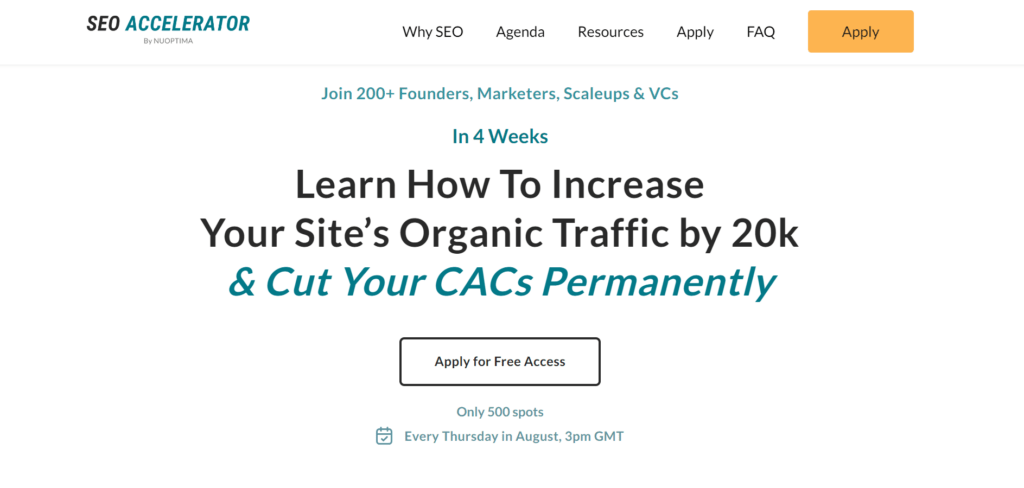
We could have gone with 100k or 50k as the enticing figure, but we had an exact case study that took a website from 0 to 20k, making it even more believable. Even if we had a website that went to 100k in organic traffic, it seems a bit far-fetched. We wanted to be realistic; our buyers are sophisticated and don’t fall for crazy stats.
Acing this landing page was crucial to getting businesses interested, so we had to make every line captivating, encouraging them to read the next.
Using social proof to showcase our leadership in this category
Next, we focused our efforts on evoking as much social proof as possible. We reached out to our network and any companies we had done SEO for, had ever created proposals for or had given free SEO advice.
We’re good at what we do, so testimonials came flying in, and many companies were happy for us to use their logos. With these, we created a wall of logos and leveraged each relationship as a teaser to get more.
This additional layer of social proof proved to people who didn’t know us that we were worthy of their time and attention. Moreover, it created a sense of demand and solidified our expertise.
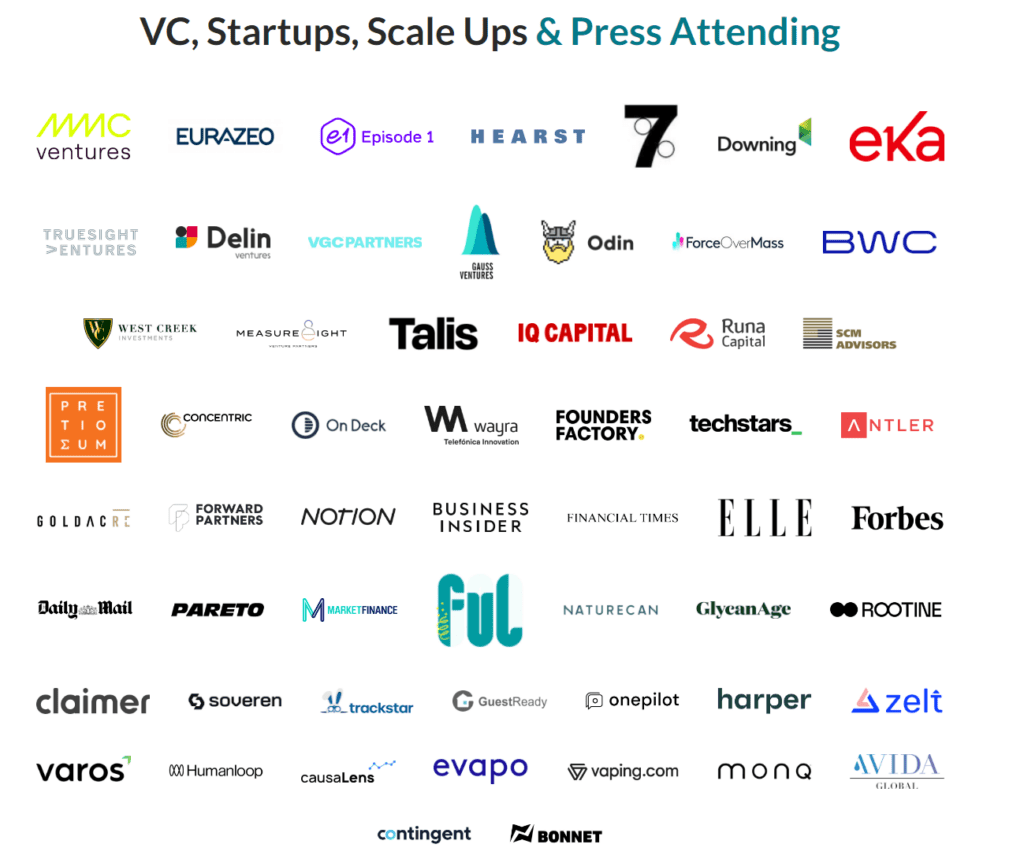
Creating a seamless sign-up process
Creating an exceptional sign-up process was a crucial step, and it took us about a week to work out. We’re not going to reinvent the wheel here, so we turned to some proven strategies for guidance. Firstly, knowing about the insane success of Harry’s referral mechanism, we knew we wanted a referral loop.
For context, Harrys captured more than 15,000 emails on day one of their campaign. By the end of the week, they had skyrocketed their numbers, getting to an astounding 100,000 emails. Their initial launch relied on email capture, and the referral system was at the very heart of it. For every friend referred, people would receive a free product. They used the idea of gamification as people tried to earn as much free product as they could. They took various steps, such as installing a visual aid to track each “players” progress, and by the end of the campaign, referrals accounted for 77% of the total campaign sign-ups, which was 65,000 people. This is an example of how powerful a good referral system can be, which is why we knew this was crucial to our own sign-up process.
Furthermore, the team didn’t want the price to be an objection to people signing up for the webinar; thus, we made it free and more accessible. Our goal was to increase reach, not make money on the front end. However, to not diminish the value, we used the words “apply for access,” similarly to how Reforge has “Apply” on a $2k coaching course. Considering how much value we planned to pack into this course, we wanted the Accelerator to feel exclusive.
We had to make sign-up seamless to maximise reach. Although we could’ve built an in-house referral tool, the team tested loads of referral SaaS tools to save time. The verdict? Honestly, they were subpar at best. Most had poor UI and were way too difficult to use.
We eventually chose one that let us do something similar to Harrys and provided milestone rewards. Every time a user signed up, they would be redirected to /refer-friend, giving them access to a free technical SEO audit and lifetime access to the recordings if they referred a certain number of friends.
The results were wild. 27% of all our sign-ups were referrals, and this is why:
- People like to access free stuff
- (More importantly) the SEO Accelerator provides free education with fantastic social proof backing it. It’s only natural that you want to be the person telling your team to sign up.
The landing page also called out personal avatars, telling readers which sessions are suitable for which employee titles. So if you’re a CMO, you could invite a content writer to attend the 2nd session. Additionally, we clearly stated how each person (investor, marketer, and founder) benefits from attending the SEO Accelerator.
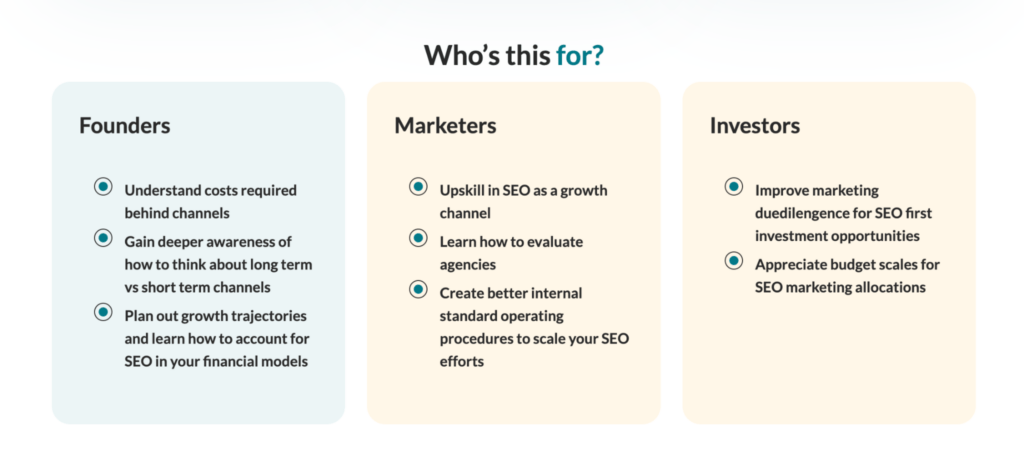
Deciding our most suitable growth channels
Our secondary goal during this preparation period was to define our growth channels for acquiring attendees. We wanted to ready all the creative marketing assets as soon as possible so we could push our course over the 4-week marketing period with minimal delays.
Fortunately, we already knew our audience lived on LinkedIn, so we decided we would do a lot of organic posting. Since we didn’t want to budget too much marketing expense on this, we avoided running LinkedIn ads as they are known to be costly.
We were yet to run any ads on social platforms for our SEO services, so we thought offering a free SEO Accelerator would introduce us effectively. We decided we’d run on Facebook & Twitter initially, but halfway through planning, we also added TikTok to our schedule.
Alongside organic posting on LinkedIn and ads across other social platforms, we also decided to do the following:
- Partnerships ended up becoming an essential channel and drove immense results
- We have some members in our team who are experienced in Cold Email and had a bunch of inboxes already warmed up. This was a good opportunity to target some key accounts.
- We also tried a tool that let us DM Reddit users at scale, but we’ll share more on this later.
Now we knew the channels, we had to create a bunch of static creative assets optimised for Twitter and Linkedin.
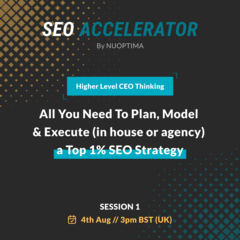
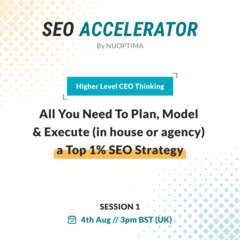
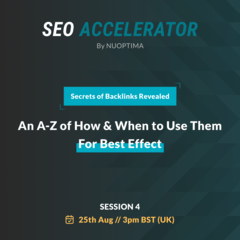
We didn’t have much time to run assets across Facebook Ads, so we crafted one creative piece. It had a thumb-stopping hook and a few different versions for opening messaging. We managed to shoot it on an iPhone over 1.5 hours. Our brilliant video editing team finished it by adding subtitles and some quick animation.
So in those 3 weeks, we were planning and creating like crazy, accomplishing our major goals, including:
- Spun up a landing page with loads of social proof
- Decided on our growth channels
- Designed all the creatives we needed to execute
Marketing the SEO Accelerator in Record Time
The groundwork was set; now, we had 4 weeks to market this event and make it a success. In this next section, we’re diving into how we executed our marketing plan and got people excited for our sessions.
Developing a killer organic LinkedIn posting strategy
Instead of posting from a company page, we utilised the 3 personal profiles of Alexej Pikovsky, Viktor Bartak, and Aman Ghataura. We leveraged each network and found these would perform better than company profiles as we already had a good rapport with our audiences.
The SEO Accelerator was huge for us and encompassed a company-wide effort. We wanted to make our social strategy seamless and cohesive where possible. So, we used all the free resources we could find on Twitter and LinkedIn to optimise a profile. Then, we set about creating a guide for our whole team to do it too.
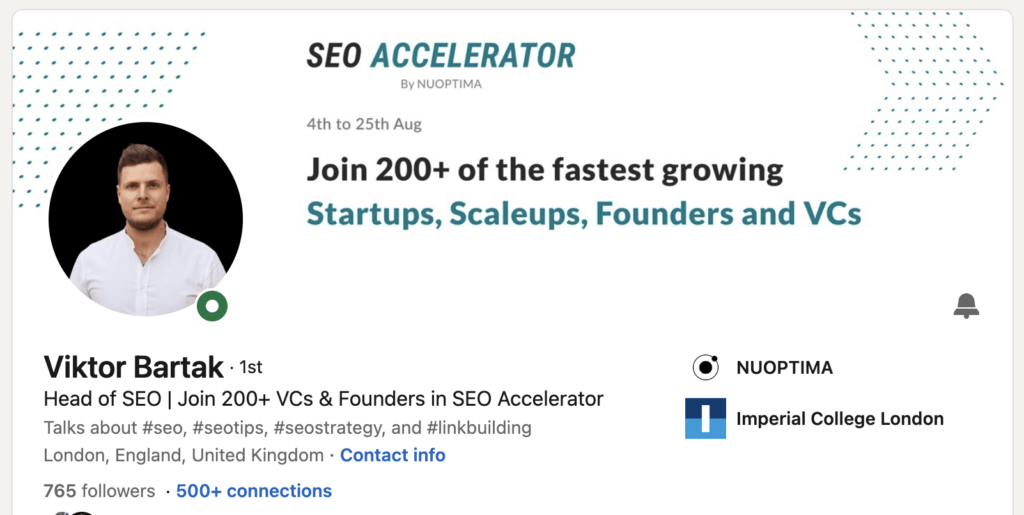
We needed to create a post formula that enticed readers in and converted well. Naturally, we analysed all the top SEO influencers to work out which of their posts performed the best. We found some obvious patterns with hooks, using big numbers, and leveraging case studies for social proof (as you can see literally everything is social proof).
Initially, we followed a similar pattern with our first handful of posts, changing the necessary sections for our case studies. Eventually, we developed a simple framework of writing out all the pains our Ideal Customer Persona feels about doing SEO and what we would have to say to make them curious enough to alleviate that pain.
For instance, people feel a genuine pain that writing SEO-optimised content is hard and demanding. With this in mind, our post hook was “Here are the 7 changes we made to our blog pieces that helped us win Featured Snippets 34% more often”.
After identifying all the pain points our audience experienced, we created posts for each one. We aimed to link hooks to real case studies, used supporting graphics as proof, and posted them across all our profiles over the 4-weeks leading to the Accelerator. Astonishingly, organic LinkedIn posting generated around 25% of our sign ups.
Testing ads on Facebook, YouTube, Twitter, and TikTok
The results from our ad strategy took us by surprise. We ran the same ad across Facebook, Youtube, Twitter, and TikTok, over the course of 4 weeks. Some were a success, and others were a learning curve, to say the least.
- Facebook gave us a Cost Per Sign Up of around £12
- Youtube gave us a Cost Per Sign Up of around £50
- TikTok didn’t work at all (we think we didn’t have the right creative)
- Twitter traffic was incredibly cheap and had huge engagement metrics but resulted in a tiny amount of sign ups. We were very, very surprised by this outcome.
Facebook yielded the best results overall, but it was clear that ads didn’t impact sign ups as much as you may think.
Cold emailing decision-makers
As we had a lot of in-house expertise in cold emailing, we took a very specific route. We ran cold email campaigns targeting CEOs, CMOs, and Head of Growths of companies that had raised money from investors in the last 18 months.
In total, we hit up around 1000 leads, generating around 30 direct sign ups (excluding referrals). That’s 3% which turned out to be pretty good, especially when you compare it to other cold email campaigns. For instance, our book-a-call rate for an SEO cold email lead gen campaign was abysmal the last time we tested (close to 0.2%), so this was performing 15x better.
The reason we attributed to this was because we were offering free value upfront. In fact, these 30 leads were incredibly valuable. This was us targeting with spears and getting in front of 30 new accounts which are qualified buyers from a budget and decision-maker perspective.
Reddit cold DM automation
When we made the decision to use Reddit’s cold DM automation as one of our growth channels, we already had a few predictions. Firstly, we’re a team of growth hackers, we’re keen to try out new tools and jump on emerging trends where we can, so naturally, we knew this would just be a bit of fun! We had low expectations and weren’t convinced it would generate any significant leads (but we’re all for being proved wrong and finding a new tool).
Considering this, why would we invest our funds and time into a potentially useless tool? Well, here’s the thing. The Reddit Cold DM tool is something that may work today but could easily become banned tomorrow. It doesn’t fit the ethos of Reddit, nor does it work with the platform. It’s a short-term tactic / hack, but it’s likely to fizzle out long-term once enough people realise the potential of this tool. So, there was no time like the present to give it a go.
We paid £500 to use the tool and send out 250 Reddit DM’s a day. We targeted all the users who mentioned SEO-related keywords in some specifically chosen SubReddits. We messaged a total of 4000 users and had a 7% reply rate. Of these, 4% or 160 were positive replies, resulting in 38 sign ups. Truthfully, this was probably our lowest quality acquisition channel.
Running partnerships
The final method to get users was to run partnerships. Our marketing was working, and within a week, we had passed 200 high-quality sign-ups. These were VC-backed founders, startups, marketers, and scaleups. A really valuable audience.
With this, we leveraged the social proof to gain partnerships with organisations we were friendly with. We approached them offering a chance to gain awareness in front of this acquired audience in exchange for them running an email shout-out to their audience. Consequently, no money was exchanged.
It was important that companies we reached out to had similar audiences to ours to ensure there was mutual benefit. These targeted partnerships easily pulled in additional 150 sign ups.
The Final Verdict: Did Our Hard Work Pull Off?
The focus of the SEO Accelerator was to expand our brand’s reach and show off our expertise. We wanted to generate relevant, quality leads and start converting them into clients. To do this, we had to address why companies weren’t knocking on our door and demonstrate how we could solve their pain points. However, did it pay off? What was the real result of this program?
Interestingly, a lot of our network saw our promo for the SEO Accelerator. In fact, our first closed deals came up from people in our network as they became aware we were an SEO agency and reached out to us for a proposal. To put it plainly, this was easy revenue; we closed quickly.
Moreover, we were gaining massive reach through the LinkedIn algorithm and engagement. Alongside this, our profiles were optimised, so cold buyers, who happened to be looking for an SEO agency, stumbled upon our profiles and booked calls inbound. Again, revenue closed even before we had started the SEO Accelerator. With that said, partnerships easily became one of our favourite growth channels, and it’s something we’re going to double down on in the future.
Finally, throughout the Accelerator, attendees were booking calls on our website through our Calendly form to gain more insight into how they can work with us. We had successfully demonstrated our prowess and ability. We never pitched or tried to sell but simply showed off our case studies, and the clients came inbound.
